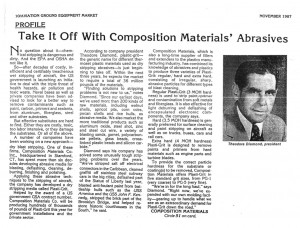This article was originally published in November, 1987 in Aviation Ground Equipment Market. The article provides an historic overview of the development of Plasti-Grit® plastic blast media.
No question about it — chemical stripping is dangerous and dirty. And the EPA and OSHA do not like it. So — after decades of costly, inefficient and certifiably treacherous wet stripping of aircraft, the US government is launching an initiative to deal with the triple threat of health hazards, air pollution and toxic waste. Naval bases as well as private companies have been advised to look for a better way to remove contaminants such as paint, carbon, primers and sealants, from aluminum, fiberglass, steel and other substrates.
But effective substitutes are hard to find. Either they are costly, toxic, too labor intensive, or they damage the substrates. Or all of the above.
A number of companies have been working on a new approach — dry blast stripping. One of these firms, Composition Materials Co., Inc., headquartered in Stamford, CT, has spent more than six decades developing abrasive media for blasting, deflashing, cleaning, deburring, finishing and polishing.
Applying these abrasive techniques to the stripping of aircraft, the company has developed a dry stripping media called Plasti-Grit.
Helped by the award of a US government GSA contract number, Composition Materials Co., Inc. will be producing hundreds of thousands of pounds of Plasti-Grit this year for government installations and the private sector.
According to company president Theodore Diamond, plastic-grit — the generic name for different thermoset plastic materials used as dry stripping abrasives — is just beginning to take off. Within the next three years, he expects the market to require a total of 36 million pounds of the materials.
“Finding solutions to stripping problems is not new to us,” notes Diamond. “Since our earliest days, we’ve used more than 200 kinds of raw materials, including walnut shells, apricot pits, corn cobs, pecan shells and rice hulls, as abrasive media. We also market the more traditional products such as aluminum oxide, steel shot, zinc and steel cut wire, a variety of blasting sands, garnet, polycarbonate pellets, glass beads, cross-linked plastic beads and silicon carbide.”
Diamond says his company has solved some unusually tough stripping problems over the years.
‘We’ve stripped salt off electrical connectors in the Caribbean, cleaned graffiti off stainless steel subway cars in the big cities, deflashed part of the Statue of Liberty last year, blasted anti-foulant paint from battleship hulls such as the USS America and the USS John F. Kennedy, Stripped the brick part of the Brooklyn Bridge, and helped restore historic courthouses in the South,” he said.
Composition Materials, which is also a long-time supplier of fillers and extenders to the plastics manufacturing industry, has combined its knowledge of abrasives and plastics to produce three varieties of Plasti-Grit: regular, hard and extra hard, consisting of irregular, sharp, abrasive particles for different types of blast cleaning.
Regular Plasti-Grit (3 MOH hardness) is used to strip paint, primer and contamination from soft metals and fiberglass. It is also effective for light deburring and deflashing of encapsulated electronic components, the company says.
Hard (3.5 MOH hardness) is generally preferred for surface cleaning and paint stripping on aircraft as well as on trucks, buses, cars and rail cars.
Extra hard (4 MOH hardness) Plasti-Grit is designed to remove paints and primers from hard materials such as engine parts and turbine blades.
To provide the correct particle hardness for the substrate or coating(s) to be removed, Composition Materials offers Plasti-Grit in five standard grit sizes, from PG-1 (very coarse) to PG-5 (very fine).
“We’re in for the long haul,” says Diamond. “Right now, we’ve expanded with our own molding facility — gearing up to handle what we see as an extraordinary demand for Plasti-Grit down the road.”
*Regular (3 MOH) Plasti-Grit® is Polyester, Hard (3.5 MOH) Plasti-Grit® is Urea, and Extra Hard (4 MOH) is Melamine.
Since this article was written in 1987, Composition Materials has been a leading manufacturer of Plasti-Grit® plastic blast media worldwide. Plasti-Grit® is now available in 5 types, including Clear-Cut® — a clear thermoset plastic grit used for blasting soft substrates such as fiberglass, as well as an additive in paints, coatings, flooring, resins and plastics.
For detailed information on Plasti-Grit®: Plastic Blast Media.

